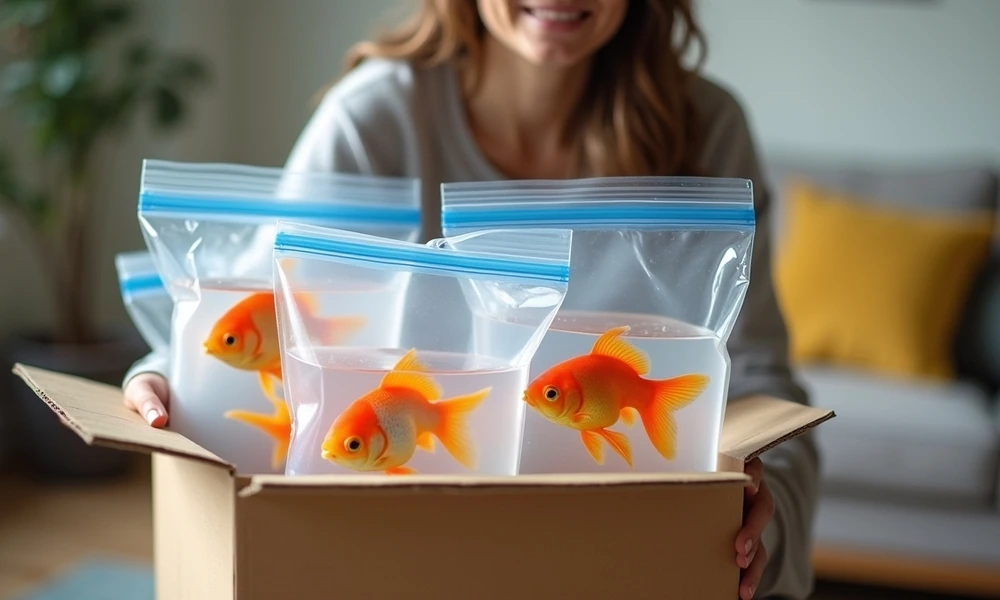How to transport fish when moving can feel challenging, but with the right approach, it’s completely manageable. Fish are delicate creatures that can easily become stressed by changes in water quality, temperature, or handling, so proper preparation is essential for their safety. Whether you’re planning a short trip across town or a long-distance relocation, knowing the best methods for fish transport can make the process smoother. In this guide, you’ll learn step-by-step how to transport fish for moving, the essential tools you’ll need, and when it might be worth hiring a professional moving service to handle the job with care.
Understand the Challenges of Moving Fish

Fish Are Sensitive to Change
When it comes to fish transportation, even small changes in temperature, water quality, or handling can cause stress. Fish have delicate immune systems, and sudden shifts in their environment can lead to illness or even death. That’s why moving with fish requires planning ahead to minimize these risks.
Short-Distance vs. Long-Distance Moves
For short-distance moves, you can often keep your fish in sealed bags or small containers for a few hours without major issues. However, long-distance fish transportation involves greater challenges such as maintaining stable water temperature, ensuring enough oxygen, and preventing prolonged stress. Longer moves may require specialized equipment or professional help to keep your fish safe and healthy throughout the journey.
Tools Required for Transporting Fish When Moving
When planning fish transportation, having the right tools can make all the difference in keeping your pets safe and stress-free. Here’s a list of essential items and why they’re important for moving with fish:
1. Fish Bags (Oxygen-Filled for Longer Trips)
Special fish bags allow you to safely hold your fish during travel. For long-distance moves, oxygen-filled bags help keep the water fresh and breathable.
2. Buckets with Secure Lids
Sturdy buckets provide more space for fish to move and can be useful for larger species. Lids prevent spills and keep fish from jumping out.
3. Portable Air Pumps
These pumps help maintain oxygen levels in the water, especially during long journeys where fish may be in containers for several hours.
4. Thermal Insulation Materials
Insulating blankets, foam, or thermal wraps help maintain a stable water temperature, preventing your fish from getting too hot or too cold.
5. Water Conditioner
Adding water conditioner neutralizes harmful chemicals in tap water and reduces stress on your fish during the move.
6. Fish Nets
A soft fish net makes it easier to gently catch and transfer fish without injuring them.
7. Coolers or Insulated Containers
Coolers keep the fish bags at a consistent temperature and shield them from sunlight or sudden temperature changes.
By using these tools, you give your fish the best chance of staying healthy during fish transportation, whether you’re moving across town or across the country.
Prepare Your Fish for Travel
Before you transport fish for moving, proper preparation is essential to keep them healthy and stress-free during the journey. Follow these simple steps to get your fish ready:
Step 1: Stop Feeding Fish 24–48 Hours Before the Move
Fish produce waste quickly, and feeding them right before travel can cause water contamination. Stopping their food for a day or two ensures cleaner water and a safer trip.
Step 2: Perform Partial Water Changes
Replace about 25–30% of the tank water with fresh, conditioned water. This keeps water clean while maintaining familiar chemistry for your fish.
Step 3: Check and Adjust the Temperature
Ensure the tank water matches the expected travel environment. Sudden temperature changes can shock fish, so stability is key.
Step 4: Inspect and Clean Transport Containers
Thoroughly clean all fish bags, buckets, or containers before use. This prevents harmful bacteria from harming your fish during the move.
By taking these steps, you create a stable and safe environment to transport fish for moving, whether it’s a quick relocation or a longer journey.
You may read Tips for Moving With Dogs & Cats.
How to Transport Fish When Moving in Five Easy Steps

If you’re moving with fish, following a clear process will help reduce stress and keep them safe throughout the journey. Here’s how to do it:
Step 1: Gently Catch and Bag the Fish
Use a soft fish net to carefully catch your fish. Avoid chasing them too much, as this can cause stress. Place them in sturdy fish bags designed for transport.
Step 2: Fill Transport Bags with Tank Water
Use water from your current aquarium so the fish remain in familiar conditions. Fill the bags about one-third with water and two-thirds with air, then secure them tightly with rubber bands.
Step 3: Place Bags Inside Insulated Containers
Coolers or foam boxes help regulate temperature and protect the fish from light and sudden temperature changes during the move.
Step 4: Stabilize Containers in Your Vehicle
Secure containers so they won’t tip or shift while driving. Sudden movements can stress fish or damage the bags.
Step 5: Set Up the Tank Quickly at the New Home
Once you arrive, set up the aquarium right away. Acclimate fish slowly by letting the bag float in the tank for 15–20 minutes before releasing them.
By following these steps, moving with fish becomes a much smoother and safer experience, ensuring your aquatic pets arrive happy and healthy.
Hire a Professional Moving Service
Sometimes, the safest choice for fish transportation is to let experts handle the job. If you own rare, delicate, or large fish, or if you’re moving long-distance, hiring professionals can save time, reduce stress, and ensure your fish arrive healthy.
Why Choose Movers Experienced with Pets and Aquariums
Professional movers who understand aquarium care know how to handle tanks, manage temperature control, and secure fish during transit. They also have the right equipment and packing methods to protect both your fish and their habitat.
Chamomile Go – Your Trusted Moving Partner in Sherman Oaks
At Chamomile Go, we specialize in safe and reliable moving services, including the careful handling of aquariums and live fish. Our moving services in Sherman Oaks are designed to give you peace of mind, whether you’re relocating locally or across the state. We use proper tools, temperature-regulated transport, and gentle handling methods to make sure your aquatic pets are protected every step of the way.
When you choose Chamomile Go, you’re not just getting movers you’re getting a team that truly cares about the well-being of your fish and the safe transport of your aquarium.
Final Thoughts
Learning how to transport fish when moving is all about preparation, the right tools, and gentle handling. By understanding the unique needs of your fish, you can make the journey safe and stress-free for your aquatic pets. Whether it’s a short move or a cross-city relocation, every step counts from proper bagging and temperature control to setting up the tank quickly at your new home. And if you want complete peace of mind, let Chamomile Go take care of everything. Our expert moving team in Sherman Oaks knows exactly how to handle aquariums and live fish, ensuring they arrive healthy and happy. Don’t take chances with your pets contact Chamomile Go today and move with confidence.
FAQs
Q1: How Long Can Fish Stay In A Bag During Transport?
Most fish can stay in a properly filled transport bag for 6–8 hours. For longer trips, use oxygen-filled bags and insulated containers to maintain water temperature.
Q2: What Is The Safest Way To Transport Fish For Moving?
The safest method is to place fish in oxygen-filled bags with their existing tank water, then store the bags in insulated containers to protect against temperature changes.
Q3: Can I Move My Fish In Their Tank With Water Still In It?
No, it’s not recommended. Moving a tank with water inside can damage the tank and stress the fish. Always transport fish separately and move the tank empty.
Q4: How Do I Prepare My Fish For Travel?
Stop feeding them 24–48 hours before the move, perform a partial water change, and clean the transport containers to ensure a safe environment.
Q5: Should I Hire A Professional For Fish Transportation?
If you have valuable or delicate fish, or if it’s a long-distance move, hiring a professional moving service experienced with aquariums like Chamomile Go can ensure safer handling.





